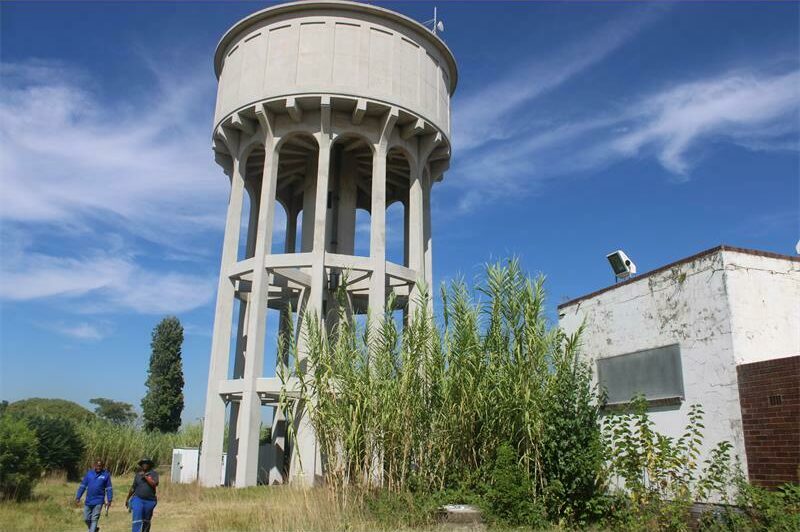Johannesburg Water (JW) hosted the media for an informative tour of Sandton’s water system on March 12.
The tour began at the Bryanston complex (containing reservoirs, a water pump and a tower) where electromechanical department manager Gugulethu Quma began breaking down Sandton’s drinking water system, from the supplier to the tap.
Watch:
“This is the biggest system within the city. It’s number one as far as consumption and demand,” Quma said.
“We’ve got five reservoirs around us that, combined, make up 100 megalitres, and we have a tower that holds about 1.2 megalitres.
“Bryanston complex supplies Bryanston, certain areas of Randburg and Fourways, and all the surrounding areas are supplied from this system.”
Quma gave a short history of the complex, revealing that the first reservoir was built in 1969 and the latest in 1998. “The demand [for water] is still growing, and in the future, we will need to add additional capacity as far as meeting that demand.”
Quma dismissed suggestions that the tour was only arranged due to the recent 10-day water outage across the northern suburbs.
“This tour was arranged way before we had the outage and the current crisis which we are handling,” said Quma. “We wanted to have an opportunity to inform the residents of the city, particularly residents of Sandton, in terms of where they are getting water from, who is supplying Sandton, where are our challenges are and what are our constraints.”
He concluded the Bryanston leg of the tour by stating that JW would always honour its obligation to provide an alternate water supply when they were unable to supply the precious resource for more than 24 hours. “In the metropolitan space, it is not ideal to supply customers in formal suburbs with alternate water – your stationary tank and roving trucks.”
The tour cohort travelled to the Marlboro and Illovo reservoirs as part of the scheduled route, ending at the JW Zandfontein depot for any clarifications.
The tour put into perspective how water pipe bursts and leaks are causal to ageing infrastructure, seeing as the installations of water pipes across Sandton began in the 1950s.
“Sandton is the economic hub of Johannesburg. The industry is based here; we get a lot of tourists, so we must keep the Sandton area functioning, ” said Johannesburg Water’s (JW) spokesperson Nombuso Shabalala.
Shabalala wrapped things up at the Zandfontein depot, speaking about JW’s plans moving forward. “An immediate one is that we need to attend to leaks and bursts promptly when they’re reported. I know that we do fix and replace ageing pipes and other infrastructure,” Shabalala said. “JW has a pipe replacement project in the works, however, we’ve got resource constraints. Ideally, we should replace the entire system with new pipes… we have challenges with underfunding for our infrastructure.”
The five reservoir complexes that make up the Sandton system (and their capacity) are:
- Bryanston complex can store 101.2 megalitres of water between five reservoirs and a tower.
- Illovo complex can store 49.2 megalitres of water between eight reservoirs and a tower.
- Linbro Park complex can store 42 megalitres of water between two reservoirs.
- Marlboro complex can store 39 megalitres of water across three reservoirs.
- Morningside complex stores nine megalitres of water in a single reservoir.
The Sandton system supplies water across northern Johannesburg including: - Region E: Sandton, Alexandra, Wynberg, Lombardy East and Houghton;
- Region A: Sunninghill
- Region C: Danfern, Craigavon
Who’s who?
- Reggie Wesso is the regional manager for Johannesburg Water’s Zandfontein north and south depots
- Gugulethu Quma is the electromechanical department manager
- Nombuso Shabalala is the JW spokesperson, as well as the communications and marketing manager in the department of stakeholder relations and communications department
- Nolwazi Dhlamini serves as an external communications officer. She navigates enquiries from the media, and issues responses on behalf of Shabalala.
Fast facts about the Sandton system:
- The system provides 16 megalitres of water a day through the Rand Water supply meters known as Palmiet water pump Sandton 1 and 2
- The entire system operates on a network of pipes that cover a distance of about 2 200km long. The pipes range from 75mm to
1 500mm in diameter. - The Illovo reservoirs are the highest and farthest from the point of supply, and take the longest to recover after the closing of Sandton 1 and 2 meters.
- The Zandfontein depot is serviced through three other systems: through Randjieslaagte (parts of Alexandra), Parktown 2 (Saxonwold, Parkview, Parkwood, Melrose), and Linden 1 reservoirs and tower (Blairgowrie, Bordeaux)
Where does Sandton’s water come from?
Rand Water supplies Sandton’s water system through the Palmiet water pump.
- Linbro Park direct feed: has an average annual daily demand (AADD) of 0.432 megaliters per day, serving 157 stands.
- Marlboro direct feed: has an AADD of 12.9 megalitres per day, serving 4 884 stands. (Stands include residential, business and government properties across Sandton).
What are Johannesburg Water’s services?
- Supplies 1.6 billion litres (160 megalitres) of potable water daily through a network of 129 reservoirs, and water towers.
- Provides water and sanitation services to areas across Johannesburg from as far as Orange Farm, Midrand, Roodepoort and Alexandra.
Related articles: Another unattended Joburg Water excavation
